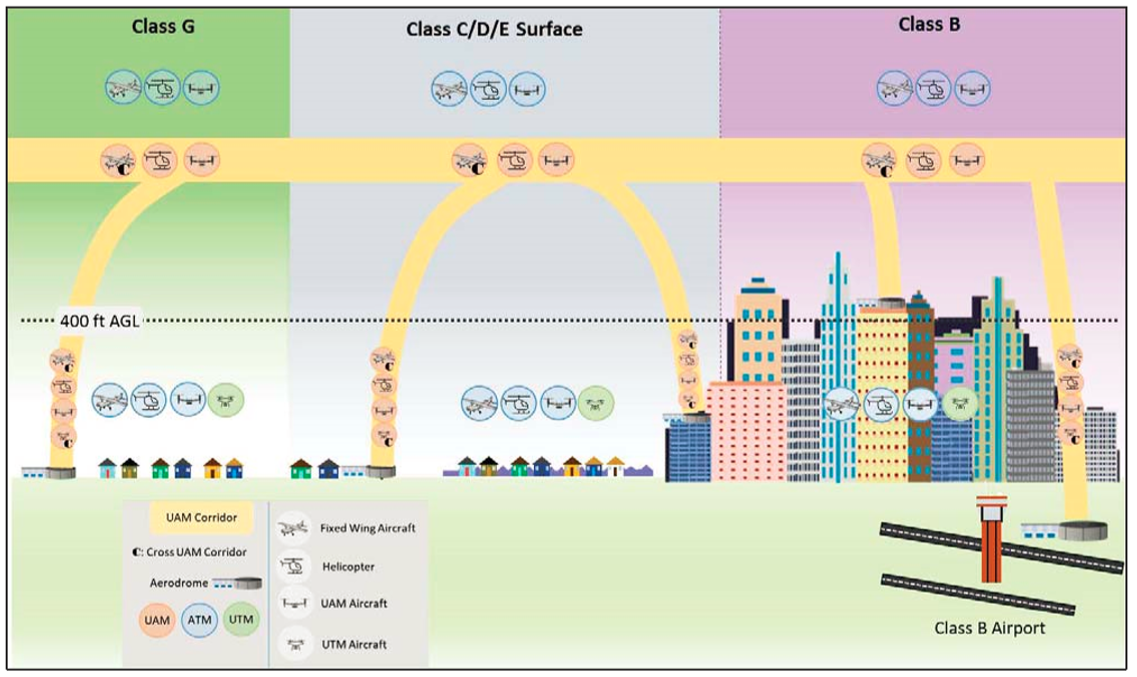UAM発展のためには専用コリドー空域の設定が不可欠 | FAA Sees Airspace Corridors As Key To Scaling Up UAM

FAAは都市の上空に都市型エアタクシー用のコリドー(専用空域)を設定し、エアタクシー事業の拡大を後押しする考えだ。
このコリドーは、同局がはじめて打ち出したUAM(都市型エアモビリティ:Urban Air Mobility)の運用コンセプト「ConOps 1.0」の目玉である。
FAAはUAM運用コンセプトの開発を3つの段階に分けている。まずは現行ルールの下で運航を始め、続いてConOps 1.0ルールの下でUAMコリドー内を有人操縦で飛行し、最終的には自律飛行機や遠隔操縦機による、成熟した高頻度の運航に移行する。
最初の低頻度なUAMサービスは、ヘリコプター運航用の既存ルールとインフラを使用する。ただし、そこから飛行頻度が増加していくにつれて、有人操縦されるエアタクシーが機体性能に合わせて設定されるコリドーを飛行し、特定のUAM発着場を結ぶような運航が増えるとFAAは予想している。
これらの空域内では、各機体はUAMに特化して設定された規則・手順・要求性能に基づいて運航されることになる。コリドー内での運航規則は、コリドーが通過する空域に設定されたクラスに関わらず一律だ。コリドー外では、高度400フィート以下の空域は無人交通管理(Unmanned Traffic Management:UTM)空域となり、400フィート以上の空域では既存の航空管制が行われる。
UAMコリドー内では、地域により制定されFAAが承認する、協調的交通管理が行われる。運航者は「UAMサービスプロバイダー(Providers of services for UAM:PSU)」を利用し、UAM運航に関する情報の収集や交換を行う。
PSUは運航計画・飛行目的の共有・戦略/戦術的な針路変更・空域管理・不測の事態への対処…などを支援する。彼らはUTM空域のサポートを受け持つ、無人機システムサービスサプライヤー(Unmanned aircraft system Service Suppliers:USS)とも情報交換を行う。
FAAがUAM向けに打ち出したConOpsの初期段階は、運航頻度の拡大や、機体の自動運航化を促すことにつながり、これは低コストで高密度な運航を実現する上で鍵となるものだ。
ConOps 1.0では、自動化のレベルを3つに分けている。機内のパイロットが直接操縦する「human-within-the-loop」、機内のパイロットが監視制御と積極的モニタリングを行う「human-on-the-loop」、そして遠隔オペレーターが受動的モニタリングを行い、必要に応じて遠隔操縦する「human-over-the-loopだ。
以上は、Graham Warwickが Aerospace Daily & Defense Report いた記事です。Aviation Week Intelligence Network (AWIN) のメンバーシップにご登録いただくと、開発プログラムやフリートの情報、会社や連絡先データベースへのアクセスが可能になり、新たなビジネスの発見やマーケット動向を把握することができます。貴社向けにカスタマイズされた製品デモをリクエスト。
The FAA envisages creating dedicated corridors in airspace over cities to enable urban air-taxi services to scale up.
These corridors are a key feature of the agency’s first concept of operations, ConOps 1.0, for urban air mobility (UAM).
The FAA foresees three stages of UAM development, beginning with initial operations under current rules, progressing to ConOps 1.0 operations with piloted vehicles in UAM corridors, and reaching mature, high-tempo operations with automated vehicles and remote operators.
Initial, low-tempo UAM services will use existing rules and infrastructure for helicopter operations. But as the tempo increases the FAA foresees piloted air taxis flying between specific UAM aerodromes via dedicated corridors of performance-based airspace.
Within these corridors, vehicles will operate under UAM-specific rules, procedures and performance requirements. These will not vary with the class of airspace through which the corridor passes. Outside the corridor will be unmanned traffic management (UTM) airspace, below 400 ft., and airspace that comes under existing air traffic management rules.
Within the UAM corridors, cooperative traffic management will be based on rules developed by the community and approved by the FAA. “Providers of services for UAM,” or PSUs, will be used by operators to receive and exchange information during UAM operations.
PSUs will support operations planning, flight intent sharing, strategic and tactical deconfliction, airspace management and off-nominal operations. These service providers will exchange information with the unmanned aircraft system service suppliers, or USS, supporting UTM airspace.
The FAA’s initial conops for UAM supports both the scaling up of operations from low to higher tempo, and increasing automation of the vehicles—seen as key to enabling affordable, high-density services.
ConOps 1.0 lays out three levels of automation: human-within-the-loop, with an onboard pilot in direct control; human-on-the-loop, with supervisory control and active monitoring; and human-over-the-loop, with passive monitoring by a remote operator who is engaged when required by the automation.


